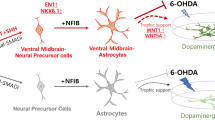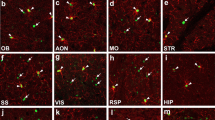Abstract
Being supportive cells for neurons in the central nervous system, astrocytes have recently found to be associated with neurogenesis. Ventral mesencephalon (VM) astrocytes were also detected being instructive for VM dopaminergic (DA) neurogenesis, but the underling mechanisms are still unclear. This research is to figure out whether VM astrocytes are more efficient than those from other brain regions in inducing VM DA neurons from their precursors and whether transforming growth factor-βs (TGF-βs) are the underlying molecules. We found that, compared with astrocytes preparations from striatum and hippocampus, VM astrocytes preparations displayed markedly higher efficacy in inducing DA neurogenesis. Besides, they also expressed higher level of TGF-β3 than those of two other regions. When TGF-β3 gene expression in astrocytes preparations was inhibited by its antisense oligonucleotide, the induction of DA neurons decreased to a similar level among these three astrocytes preparations. Thus, our experiment indicates that VM astrocytes preparations which contained highly purified astrocytes are more efficient in inducing DA neurogenesis than those from other regions. Furthermore, it also suggests that the regional differences are regulated by different expression levels of TGF-β3 in those astrocytes preparations from different derivations.







Similar content being viewed by others
References
Banker, G. A. (1980). Trophic interactions between astroglial cells and hippocampal neurons in culture. Science, 209, 809–810. doi:10.1126/science.7403847.
Castelo-Branco, G., & Arenas, E. (2006). Function of Wnts in dopaminergic neuron development. Neuro-Degenerative Diseases, 3, 5–11. doi:10.1159/000092086.
Castelo-Branco, G., Sousa, K. M., Bryja, V., Pinto, L., Wagner, J., & Arenas, E. (2006). Ventral midbrain glia express region-specific transcription factors and regulate dopaminergic neurogenesis through Wnt-5a secretion. Molecular and Cellular Neurosciences, 31, 251–262. doi:10.1016/j.mcn.2005.09.014.
Close, J. L., Gumuscu, B., & Reh, T. A. (2005). Retinal neurons regulate proliferation of postnatal progenitors and Muller glia in the rat retina via TGF beta signaling. Development, 132, 3015–3026. doi:10.1242/dev.01882.
De, A., Hentges, S., Boyadjieva, N., & Sarkar, D. K. (2001). Effect of antisense suppression of transforming growth factor-beta3 gene on lactotropic cell proliferation. Journal of Neuroendocrinology, 13, 324–327. doi:10.1046/j.1365-2826.2001.00619.x.
Doetsch, F. (2003). The glial identity of neural stem cells. Nature Neuroscience, 6, 1127–1134. doi:10.1038/nn1144.
Doetsch, F., Caille, I., Lim, D. A., Garcia-Verdugo, J. M., & varez-Buylla, A. (1999). Subventricular zone astrocytes are neural stem cells in the adult mammalian brain. Cell, 97, 703–716. doi:10.1016/S0092-8674(00)80783-7.
Engele, J., Schubert, D., & Bohn, M. C. (1991). Conditioned media derived from glial cell lines promote survival and differentiation of dopaminergic neurons in vitro: Role of mesencephalic glia. Journal of Neuroscience Research, 30, 359–371. doi:10.1002/jnr.490300212.
Farkas, L. M., Dunker, N., Roussa, E., Unsicker, K., & Krieglstein, K. (2003). Transforming growth factor-beta(s) are essential for the development of midbrain dopaminergic neurons in vitro and in vivo. The Journal of Neuroscience, 23, 5178–5186.
Flanders, K. C., Ludecke, G., Engels, S., Cissel, D. S., Roberts, A. B., Kondaiah, P., et al. (1991). Localization and actions of transforming growth factor-beta s in the embryonic nervous system. Development, 113, 183–191.
Funahashi, J., Okafuji, T., Ohuchi, H., Noji, S., Tanaka, H., & Nakamura, H. (1999). Role of Pax-5 in the regulation of a mid-hindbrain organizer’s activity. Development, Growth & Differentiation, 41, 59–72. doi:10.1046/j.1440-169x.1999.00401.x.
Gomes dos Santos, A. L., Bochot, A., Tsapis, N., Artzner, F., Bejjani, R. A., Thillaye-Goldenberg, B., et al. (2006). Oligonucleotide-polyethylenimine complexes targeting retinal cells: Structural analysis and application to anti-TGFbeta-2 therapy. Pharmaceutical Research, 23, 770–781. doi:10.1007/s11095-006-9748-0.
Hall, A. C., Mira, H., Wagner, J., & Arenas, E. (2003). Region-specific effects of glia on neuronal induction and differentiation with a focus on dopaminergic neurons. Glia, 43, 47–51. doi:10.1002/glia.10229.
Hirsch, E., Graybiel, A. M., & Agid, Y. A. (1988). Melanized dopaminergic neurons are differentially susceptible to degeneration in Parkinson’s disease. Nature, 334, 345–348. doi:10.1038/334345a0.
Joannides, A., Gaughwin, P., Schwiening, C., Majed, H., Sterling, J., & Compston, A. (2004). Efficient generation of neural precursors from adult human skin: Astrocytes promote neurogenesis from skin-derived stem cells. Lancet, 364, 172–178. doi:10.1016/S0140-6736(04)16630-0.
Kim, J. Y., Koh, H. C., Lee, J. Y., Chang, M. Y., Kim, Y. C., & Chung, H. Y. (2003). Dopaminergic neuronal differentiation from rat embryonic neural precursors by Nurr1 overexpression. Journal of Neurochemistry, 85, 1443–1454. doi:10.1046/j.1471-4159.2003.01780.x.
Kornyei, Z., Szlavik, V., Szabo, B., Gocza, E., Czirok, A., & Madarasz, E. (2005). Humoral and contact interactions in astroglia/stem cell co-cultures in the course of glia-induced neurogenesis. Glia, 49, 430–444. doi:10.1002/glia.20123.
Laywell, E. D., Rakic, P., Kukekov, V. G., Holland, E. C., & Steindler, D. A. (2000). Identification of a multipotent astrocytic stem cell in the immature and adult mouse brain. Proceedings of the National Academy of Sciences of the United States of America, 97, 13883–13888. doi:10.1073/pnas.250471697.
Lim, D. A., & varez-Buylla, A. (1999). Interaction between astrocytes and adult subventricular zone precursors stimulates neurogenesis. Proceedings of the National Academy of Sciences of the United States of America, 96, 7526–7531. doi:10.1073/pnas.96.13.7526.
Lledo, P. M., Alonso, M., & Grubb, M. S. (2006). Adult neurogenesis and functional plasticity in neuronal circuits. Nature Reviews. Neuroscience, 7, 179–193. doi:10.1038/nrn1867.
Meltzer, H. Y., & Stahl, S. M. (1976). The dopamine hypothesis of schizophrenia: A review. Schizophrenia Bulletin, 2, 19–76.
Nakayama, T., Momoki-Soga, T., & Inoue, N. (2003). Astrocyte-derived factors instruct differentiation of embryonic stem cells into neurons. Neuroscience Research, 46, 241–249.
O’Malley, E. K., Sieber, B. A., Black, I. B., & Dreyfus, C. F. (1992). Mesencephalic type I astrocytes mediate the survival of substantia nigra dopaminergic neurons in culture. Brain Research, 582, 65–70. doi:10.1016/0006-8993(92)90317-3.
Patapoutian, A., & Reichardt, L. F. (2000). Roles of Wnt proteins in neural development and maintenance. Current Opinion in Neurobiology, 10, 392–399. doi:10.1016/S0959-4388(00)00100-8.
Pixley, S. K. (1992). CNS glial cells support in vitro survival, division, and differentiation of dissociated olfactory neuronal progenitor cells. Neuron, 8, 1191–1204. doi:10.1016/0896-6273(92)90139-5.
Qian, X., Shen, Q., Goderie, S. K., He, W., Capela, A., & Davis, A. A. (2000). Timing of CNS cell generation: a programmed sequence of neuron and glial cell production from isolated murine cortical stem cells. Neuron, 28, 69–80. doi:10.1016/S0896-6273(00)00086-6.
Riddle, R., & Pollock, J. D. (2003). Making connections: The development of mesencephalic dopaminergic neurons. Brain Research. Developmental Brain Research, 147, 3–21. doi:10.1016/j.devbrainres.2003.09.010.
Roussa, E., & Krieglstein, K. (2004). Induction and specification of midbrain dopaminergic cells: focus on SHH, FGF8, and TGF-beta. Cell and Tissue Research, 318, 23–33. doi:10.1007/s00441-004-0916-4.
Roussa, E., Wiehle, M., Dunker, N., Becker-Katins, S., Oehlke, O., & Krieglstein, K. (2006). Transforming growth factor beta is required for differentiation of mouse mesencephalic progenitors into dopaminergic neurons in vitro and in vivo: Ectopic induction in dorsal mesencephalon. Stem Cells (Dayton, Ohio), 24, 2120–2129. doi:10.1634/stemcells.2005-0514.
Rowitch, D. H., Echelard, Y., Danielian, P. S., Gellner, K., Brenner, S., & McMahon, A. P. (1998). Identification of an evolutionarily conserved 110 base-pair cis-acting regulatory sequence that governs Wnt-1 expression in the murine neural plate. Development, 125, 2735–2746.
Rowitch, D. H., & McMahon, A. P. (1995). Pax-2 expression in the murine neural plate precedes and encompasses the expression domains of Wnt-1 and En-1. Mechanisms of Development, 52, 3–8. doi:10.1016/0925-4773(95)00380-J.
Roy, N. S., Cleren, C., Singh, S. K., Yang, L., Beal, M. F., & Goldman, S. A. (2006). Functional engraftment of human ES cell-derived dopaminergic neurons enriched by coculture with telomerase-immortalized midbrain astrocytes. Nature Medicine, 12, 1259–1268. doi:10.1038/nm1495.
Sanai, N., Tramontin, A. D., Quinones-Hinojosa, A., Barbaro, N. M., Gupta, N., Kunwar, S., et al. (2004). Unique astrocyte ribbon in adult human brain contains neural stem cells but lacks chain migration. Nature, 427, 740–744. doi:10.1038/nature02301.
Seeman, P., Guan, H. C., & Van Tol, H. H. (1993). Dopamine D4 receptors elevated in schizophrenia. Nature, 365, 441–445. doi:10.1038/365441a0.
Smidt, M. P., & Burbach, J. P. (2007). How to make a mesodiencephalic dopaminergic neuron. Nature Reviews. Neuroscience, 8, 21–32. doi:10.1038/nrn2039.
Song, H., Stevens, C. F., & Gage, F. H. (2002). Astroglia induce neurogenesis from adult neural stem cells. Nature, 417, 39–44. doi:10.1038/417039a.
Tour, E., Pillemer, G., Gruenbaum, Y., & Fainsod, A. (2002). Otx2 can activate the isthmic organizer genetic network in the Xenopus embryo. Mechanisms of Development, 110, 3–13. doi:10.1016/S0925-4773(01)00591-3.
Ueki, T., Tanaka, M., Yamashita, K., Mikawa, S., Qiu, Z., & Maragakis, N. J. (2003). A novel secretory factor, neurogenesin-1, provides neurogenic environmental cues for neural stem cells in the adult hippocampus. The Journal of Neuroscience, 23, 11732–11740.
Unsicker, K., Flanders, K. C., Cissel, D. S., Lafyatis, R., & Sporn, M. B. (1991). Transforming growth factor beta isoforms in the adult rat central and peripheral nervous system. Neuroscience, 44, 613–625. doi:10.1016/0306-4522(91)90082-Y.
Unsicker, K., & Strelau, J. (2000). Functions of transforming growth factor-beta isoforms in the nervous system. Cues based on localization and experimental in vitro and in vivo evidence. European Journal of Biochemistry, 267, 6972–6975. doi:10.1046/j.1432-1327.2000.01824.x.
varez-Buylla, A., & Lim, D. A. (2004). For the long run: Maintaining germinal niches in the adult brain. Neuron, 41, 683–686.
Wagner, J., Akerud, P., Castro, D. S., Holm, P. C., Canals, J. M., Snyder, E. Y., et al. (1999). Induction of a midbrain dopaminergic phenotype in Nurr1-overexpressing neural stem cells by type 1 astrocytes. Nature Biotechnology, 17, 653–659. doi:10.1038/10862.
Acknowledgments
This study was supported by the National Basic Research Program of China (2006CB500700), the key project of the Beijing Natural Science Foundation (7021002). We thank Professor Riyi Shi from the Department of Basic Medical Sciences, Purdue University for the critical reading.
Author information
Authors and Affiliations
Corresponding author
Rights and permissions
About this article
Cite this article
Li, K., Xue, B., Wang, Y. et al. Ventral Mesencephalon Astrocytes Are More Efficient Than Those of Other Regions in Inducing Dopaminergic Neurons Through Higher Expression Level of TGF-β3. J Mol Neurosci 37, 288–300 (2009). https://doi.org/10.1007/s12031-008-9146-7
Received:
Accepted:
Published:
Issue Date:
DOI: https://doi.org/10.1007/s12031-008-9146-7




